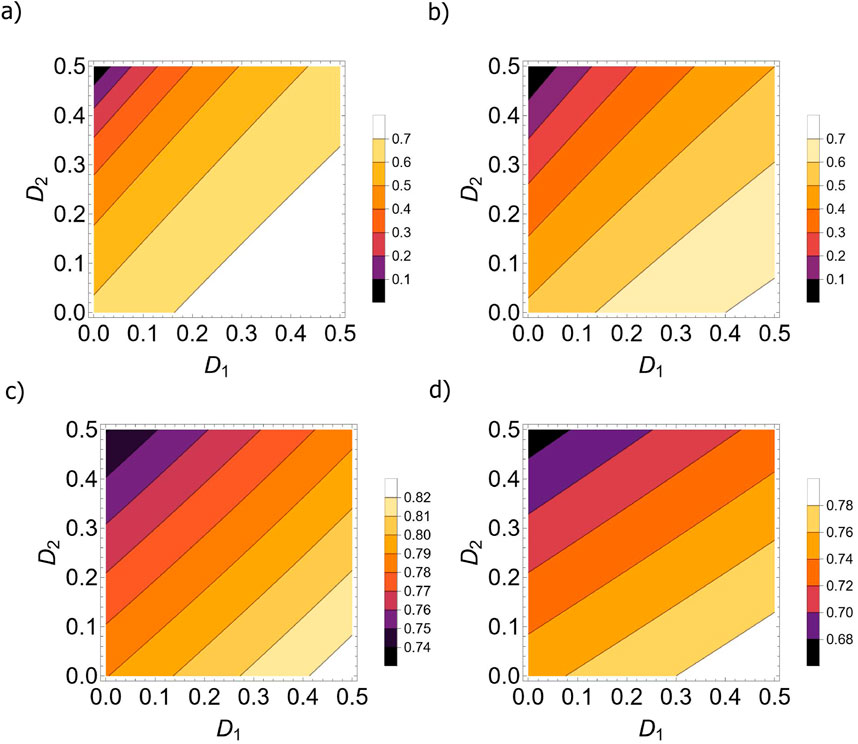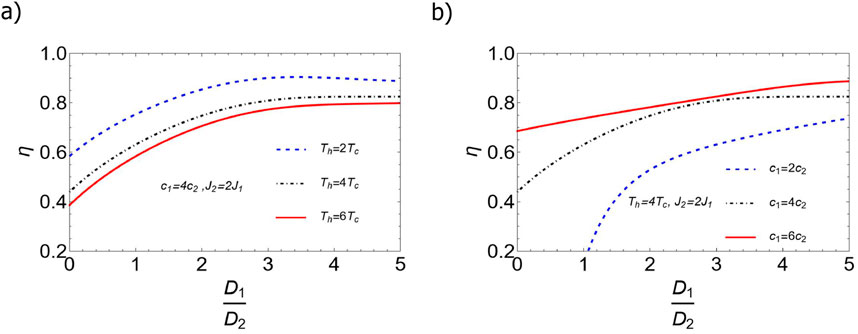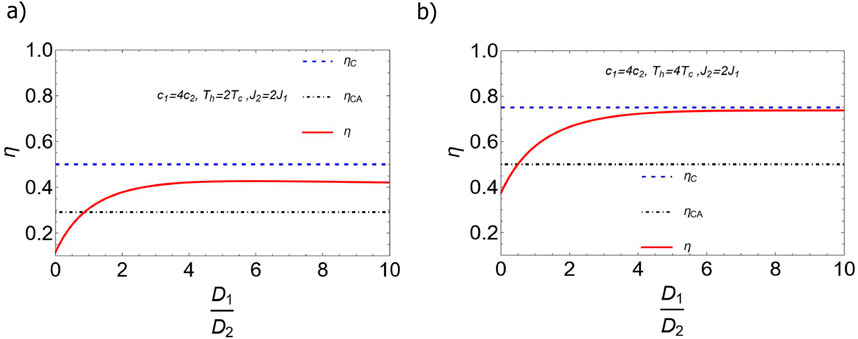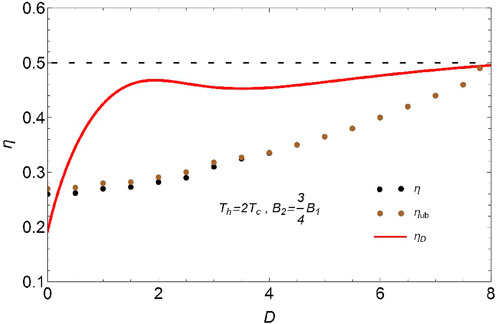- 1Department of Physics, College of Sciences, Jahrom University, Jahrom, Iran
- 2Grupo de Informação Quântica e Física Estatística, Centro de Ciências Exatas e das Tecnologias, Universidade Federal do Oeste da Bahia - Campus Reitor Edgard Santos, Barreiras, Bahia, Brazil
Quantum heat engines have attracted significant attention in recent years due to their potential to surpass classical thermodynamic limits by leveraging quantum effects such as entanglement and coherence. In this study, we analyze a quantum Stirling heat engine characterized by a working substance composed of a two-particle Heisenberg model with Dzyaloshinskii–Moriya (DM) interaction under an external magnetic field. We investigate the impact of the antisymmetric interaction on the engine’s efficiency across varying coupling parameters. Our findings demonstrate that the utilization of a two-qubit Heisenberg model in an entangled quantum Stirling heat engine can significantly enhance efficiency and performance. By optimizing the antisymmetric exchange parameters, we achieve substantial enhancements in engine efficiency, with results demonstrating that the efficiency attains remarkably high values compared to other cycles utilizing the same working substance. These enhancements are primarily influenced by the DM interaction and the entangled states of the working substance, leading to superior performance.
1 Introduction
Research in quantum thermodynamics has shown that incorporating innovative design elements and optimizing thermodynamic cycles can significantly enhance the performance of Quantum Heat Engines (QHEs) [1–5]. Over the past decade, researchers have made significant advancements in optimizing QHE performance by exploring and refining a wide range of thermodynamic cycles such as the Otto, Carnot, and Stirling cycles [6–11]. Various working substances have been suggested, including single spins, quantum oscillators, and the XYZ spin chain model with Dzyaloshinskii-Moriya (DM) interaction [12–23].
The examination of interacting qubits as operational entities within QHEs presents a compelling issue in quantum physics. In recent years, there has been significant investigation into the interplay of two qubits using the Heisenberg spin chain model, encompassing interactions between spins as well as spin-orbit coupling such as DM interaction [24]. Huang et al. [25] conducted an extensive examination of a quantum Otto heat engine using a three-qubit XXZ model, considering the influences of DM interaction and magnetic field. Their study explored the effects of interaction and anisotropic parameters on both the work output and efficiency of QHEs. Similarly, Purkait et al. [26] scrutinized the efficiency of quantum Stirling engines employing a working system of two Heisenberg-coupled spins near a Quantum Critical Point, attributing enhancements to the non-analytic nature of spin-spin correlation and entanglement. Additionally, Zhao et al. [27] investigated an entangled quantum Otto heat engine utilizing two-spin systems with DM interaction, revealing the significant role of DM interaction in the engine’s thermodynamics.
Moreover, scientists have explored how quantum coherence and entanglement affect QHE efficiency, providing new insights into improving their performance [28–33]. Various quantum thermodynamic cycles, including the Otto and Stirling cycles within two-spin working systems, have been studied to elucidate the impact of entanglement on QHE performance [5, 34–38].
In this context, our work focuses on elucidating the properties of an operational material and the theoretical framework for quantum heat engines (QHEs). We have studied a two-particle Heisenberg model with DM interaction under an external magnetic field as the working substance of a quantum Stirling heat engine. Unlike previous studies focusing on the Otto cycle [21, 27, 39], this work investigates the role of the Dzyaloshinskii–Moriya interaction within a Stirling cycle framework, which provides unique insights into the interplay between entanglement and antisymmetric exchange parameters. The study examines the impact of antisymmetric interaction on engine efficiency by altering coupling parameters and entanglement levels in the initial and third stages of the cycle. Our findings indicate that the DM interaction significantly enhances efficiency, revealing critical thresholds that optimize performance under different operational parameters. Optimizing these parameters can significantly improve efficiency, surpassing the Curzon-Ahlborn efficiency and reaching the Carnot limit. Additionally, fine-tuning entanglement levels has the potential to enhance efficiency. These results suggests that quantum heat engines have the potential to achieve higher performance levels through the exploration of antisymmetric aspects of spin systems.
2 Working substance: two-qubit isotropic Heisenberg XYZ model
Let us start by examining a two-qubit
where
The four eigenvalues of this Hamiltonian can be obtained as follows:
We determine the occupation probabilities, denoted as
where
3 Quantum stirling heat engine and the Heisenberg model
The universal behavior of quantum heat engines was extensively discussed in the academic literature, operating within the confines of all four thermodynamic regimes sanctioned by the Clausius formulation of the second law [40, 42–47]. This accomplishment is realized through the precise manipulation of reservoir temperatures and working parameters. In particular, quantum Stirling cycles applied in magnetic systems present themselves as promising alternatives for developing universal quantum heat engines. A quantum Stirling cycle is composed of two quantum isothermal processes and two quantum isochoric processes [48, 49]. It can be elucidated by analyzing the energy exchange in each step of the cycle:
Stage 1: An isothermal expansion occurs when the system is connected to a hot reservoir at a constant temperature
Stage 2: A quantum isochoric process occurs in: [
Stage 3: A quantum isothermal compression process is described: [
Stage 4: The final step is a quantum isochoric process: [
To assess the impact of quantum entanglement on the energy exchange of the quantum Stirling cycle, we measure the entanglement present in the thermal equilibrium state using the widely recognized Wootters concurrence [50–52]. This allows us to evaluate the entanglement of the bipartite system, which is characterized as
Therefore, the entanglement at the end of the first stage and the third stage of the quantum Stirling cycle can be represented as
To understand how these interconnections affect important thermodynamic properties, we can analyze Equations 7, 8. By using these equations, we can express the magnetic field based on entanglement with an analytical solution given by:
By substituting Equations 9, 10 to the heat exchanged in each step of the Stirling cycle, Equations 3–6, we can evaluate the heat absorbed
4 Results and discussion
In this section, we will study in detail the impact of the quantum entanglement, temperatures, and antisymmetric exchange parameters on the thermal efficiency of the two-qubit isotropic Heisenberg XYZ model used as a working substance in the quantum Stirling heat engine. The thermodynamic efficiency
Thus, one can examine the influences of DM interaction parameters on the efficiency and plot it as a function of the above-mentioned parameters.
The variation of the efficiency as a function of antisymmetric exchange parameters

Figure 1. (Color online) Variation of the efficiency
The graphical representation demonstrates that variations in the antisymmetric exchange result in discernible fluctuations in the efficiency value. A comparative analysis between Figures 1A, B reveal that elevating the temperature of the hot reservoir while maintaining the antisymmetric parameter constant produces a significant impact on the efficiency. The upper limit of
In Figure 1D, we plot a similar figure to Figure 1C except for
In Figure 2, we plot the efficiency of the Quantum Stirling heat engine in terms of the ratio between the antisymmetric exchange parameters

Figure 2. (Color online) Efficiency of the quantum Stirling heat engine as a function of
To validate this improvement and highlight the potential of entangled heat engines to surpass traditional thermodynamic cycles under certain conditions, Figure 3 shows the efficiency

Figure 3. (Color online) Efficiency of the quantum Stirling heat engine as a function of
Furthermore, in order to compare our results with previous implementations of other quantum cycles [27], we provide a detailed comparison based on the efficiency as a function of the Dzyaloshinskii-Moriya (DM) interaction parameter

Figure 4. (Color online) Comparison of the efficiency of the quantum Stirling heat engine
Our results demonstrate that, given the parameter settings of the reference [27], the efficiency of the Stirling cycle surpasses the maximum efficiency of the Otto cycle for the observed range of the antisymmetric interaction. As can be seen, while the Otto cycle efficiency gradually increases at larger antisymmetric interaction, as observed from the brown and black data points, the Stirling efficiency exhibits a steeper increase, approaching asymptotically the Carnot efficiency
5 Conclusion
In this letter, we study a four-level entangled quantum Stirling heat engine using a working substance composed of a two-particle Heisenberg model with Dzyaloshinskii-Moriya interaction under an external magnetic field. The effect of the antisymmetric interaction on the engine’s efficiency is studied by changing the coupling parameters and the degree of entanglement in the first and third steps of the cycle. Our findings indicate that optimizing the parameters associated with this interaction can lead to substantial improvements in efficiency, surpassing the value of Curzon–Ahlborn efficiency and reaching asymptotically the Carnot limit. These results highlight the potential for achieving higher performance levels in quantum heat engines exploring antisymmetric aspects of spin systems. Furthermore, our research suggests that fine-tuning the entanglement level in conjunction with the coupling parameters can result in even greater enhancements in efficiency. This demonstrates the intricate relationship between quantum effects and thermodynamic performance in spin-based systems.
Data availability statement
The original contributions presented in the study are included in the article/supplementary material, further inquiries can be directed to the corresponding authors.
Author contributions
HR-S: Writing–original draft, Writing–review and editing. CC: Writing–original draft, Writing–review and editing.
Funding
The author(s) declare that financial support was received for the research, authorship, and/or publication of this article. C. Cruz thanks the Fundação de Amparo à Pesquisa do Estado da Bahia - FAPESB for its financial support (grant numbers APP0041/2023 and PPP006/2024).
Conflict of interest
The authors declare that the research was conducted in the absence of any commercial or financial relationships that could be construed as a potential conflict of interest.
Generative AI statement
The author(s) declare that no Generative AI was used in the creation of this manuscript.
Publisher’s note
All claims expressed in this article are solely those of the authors and do not necessarily represent those of their affiliated organizations, or those of the publisher, the editors and the reviewers. Any product that may be evaluated in this article, or claim that may be made by its manufacturer, is not guaranteed or endorsed by the publisher.
References
1. Myers NM, Abah O, Deffner S, Quantum thermodynamic devices: from theoretical proposals to experimental reality. AVS Quantum Sci (2022) 4:027101. doi:10.1116/5.0083192
2. Ptaszynski K. Non-Markovian thermal operations boosting the performance of quantum heat engines. Phys Rev E (2022) 106:014114. doi:10.1103/PhysRevE.106.014114
3. xiang Deng G, Ai H, Wang B, Shao W, Liu Y, Cui Z. Exploring the optimal cycle for a quantum heat engine using reinforcement learning. Phys Rev A (2024) 109:022246. doi:10.1103/physreva.109.022246
4. Acharyya M, Chakrabarti BK. Quantum Ising heat engines: a mean field study. The Eur Phys J B (2024) 97:45. doi:10.1140/epjb/s10051-024-00681-9
5. Rastegar-Sedehi H, Cruz C. Exploring entanglement effects in a quantum stirling heat engine. Physica Scripta (2024) 99:125936. doi:10.1088/1402-4896/ad8d8e
6. Altintas F. Comparison of the coupled quantum Carnot and Otto cycles. Physica A: Stat Mech its Appl (2019) 523:40–7. doi:10.1016/j.physa.2019.01.144
7. Peterson J, Batalhão TB, Herrera M, Souza AM, Sarthour RS, Oliveira IS, et al. Experimental characterization of a spin quantum heat engine. Phys Rev Lett (2019) 123:240601. doi:10.1103/physrevlett.123.240601
8. Çakmak S. Benchmarking quantum Stirling and Otto cycles for an interacting spinsystem. J Opt Soc America B (2022) 39:1209. doi:10.1364/josab.447206
9. Pili AHB, Khordad R, Sedehi HRR. Quantum Stirling heat engine in two-coupled-qubit Heisenberg XYZ model. Eur Phys J Plus (2023) 138:871. doi:10.1140/epjp/s13360-023-04516-x
10. Pili AHB, Khordad R, Sedehi HRR, Sharifzadeh M. Influences of homogeneous and inhomogeneous magnetic fields on the performance of a quantum Stirling heat engine. Physica B: Condensed Matter (2024) 678:415748. doi:10.1016/j.physb.2024.415748
11. Rojas O, Rojas M. Quantum machines using Cu3-like compounds modeled by Heisenberg antiferromagnetic in a triangular ring. arXiv preprint arXiv:2406.01340 (2024). doi:10.48550/arXiv.2406.01340
12. Feldmann T, Kosloff R. Characteristics of the limit cycle of a reciprocating quantum heat engine. Phys Rev E (2004) 70:046110. doi:10.1103/physreve.70.046110
13. Rezek Y, Kosloff R. Irreversible performance of a quantum harmonic heat engine. New J Phys (2006) 8:83. doi:10.1088/1367-2630/8/5/083
14. Altintas F, Hardal AÜC, Müstecaplıoglu ÖE. Phys Rev E (2014) 90:032102. doi:10.1103/PhysRevE.90.032102
15. Insinga A, Andresen B, Salamon P. Thermodynamical analysis of a quantum heat engine based on harmonic oscillators. Phys Rev E (2016) 94:012119. doi:10.1103/physreve.94.012119
16. Lin B, Chen J. Performance analysis of an irreversible quantum heat engine working with harmonic oscillators. Phys Rev E (2003) 67:046105. doi:10.1103/physreve.67.046105
17. Kosloff R, Rezek Y. The quantum harmonic Otto cycle. Entropy (2017) 19:136. doi:10.3390/e19040136
18. Huang X, Xu H, Niu X, Fu Y. A special entangled quantum heat engine based on the two-qubit Heisenberg XX model. Physica Scripta (2013) 88:065008. doi:10.1088/0031-8949/88/06/065008
19. Stefanatos D. Optimal efficiency of a noisy quantum heat engine. Phys Rev E (2014) 90:012119. doi:10.1103/physreve.90.012119
20. Huang XL, Wang T, Yi XX. Quantum Brayton cycle with coupled systems as working substance. Phys Rev E (2013) 87:012144. doi:10.1103/physreve.87.012144
21. Khlifi Y, Allati AE, Salah A, Hassouni Y. Quantum heat engine based on spin isotropic Heisenberg models with Dzyaloshinskii–Moriya interaction. Int J Mod Phys B (2020) 34:2050212. doi:10.1142/S0217979220502124
22. Chen L, Liu X, Wu F, Xia S, Feng H. Exergy-based ecological optimization of an irreversible quantum Carnot heat pump with harmonic oscillators. Physica A: Stat Mech its Appl (2020) 537:122597. doi:10.1016/j.physa.2019.122597
23. Çakmak S. A feasible quantum heat engine driven by dipole-dipole interaction. Phys Lett A (2022) 422:127796. doi:10.1016/j.physleta.2021.127796
24. Khedif Y, Errehymy A, Daoud M. On the thermal nonclassical correlations in a two-spin XYZ Heisenberg model with Dzyaloshinskii–Moriya interaction. Eur Phys J Plus (2021) 136:336. doi:10.1140/epjp/s13360-021-01254-w
25. Huang X, Sun Q, Guo D, Yu Q. Quantum Otto heat engine with three-qubit XXZ model as working substance. Physica A: Stat Mech Appl (2018) 491:604–12. doi:10.1016/j.physa.2017.09.104
26. Purkait C, Biswas A. Performance of Heisenberg-coupled spins as quantum Stirling heat machine near quantum critical point. Physica A: Stat Mech Appl (2022) 442:128180. doi:10.1016/j.physleta.2022.128180
27. Zhao L-M, Zhang G-F. Entangled quantum Otto heat engines based on two-spin systems with the Dzyaloshinski–Moriya interaction. Quan Inf Process (2017) 16:216. doi:10.1007/s11128-017-1665-0
28. Camati PA, Santos JFG, Serra R. Coherence effects in the performance of the quantum Otto heat engine. Phys Rev A (2018) 99:062103. doi:10.1103/PhysRevA.99.062103
29. Brandner K, Bauer M, Seifert U. Universal coherence-induced power losses of quantum heat engines in linear response. Phys Rev Lett (2017) 119(17):170602. doi:10.1103/physrevlett.119.170602
30. Dorfman K, Xu D, Cao J. Efficiency at maximum power of a laser quantum heat engine enhanced by noise-induced coherence. Phys Rev E (2018) 97(4-1):042120. doi:10.1103/physreve.97.042120
31. Rahav S, Harbola U, Mukamel S. Heat fluctuations and coherences in a quantum heat engine. Phys Rev A (2012) 86:043843. doi:10.1103/physreva.86.043843
32. Shi Y-H, Shi H-L, Wang X-H, Hu M, Liu S, Yang W-L, et al. Quantum coherence in a quantum heat engine. J Phys A: Math Theor (2019) 53:085301. doi:10.1088/1751-8121/ab6a6b
33. Aimet S, Kwon H. Engineering a heat engine purely driven by quantum coherence. Phys Rev A (2022) 107:012221. doi:10.1103/PhysRevA.107.012221
34. Thomas G, Johal RS. Coupled quantum Otto cycle. Phys Rev E (2011) 83:031135. doi:10.1103/physreve.83.031135
35. Ma Y-H, Su S-H, Sun C-P. Quantum thermodynamic cycle with quantum phase transition. Phys Rev E (2017) 96:022143. doi:10.1103/physreve.96.022143
36. Serafini G, Zippilli S, Marzoli I. Optomechanical Stirling heat engine driven by feedback-controlled light. Phys Rev A (2020) 102:053502. doi:10.1103/physreva.102.053502
37. Yin Y, Chen L, Wu F. Performance of quantum Stirling heat engine with numerous copies of extreme relativistic particles confined in 1D potential well. Physica A: Stat Mech its Appl (2018) 503:58–70. doi:10.1016/j.physa.2018.02.202
38. Gupt N, Bhattacharyya S, Ghosh A. Statistical generalization of regenerative bosonic and fermionic Stirling cycles. Phys Rev E (2021) 104:054130. doi:10.1103/physreve.104.054130
39. Asadian M, Ahadpour S, Mirmasoudi F. Quantum correlated heat engine in XY chain with Dzyaloshinskii–Moriya interactions. Scientific Rep (2022) 12:7081. doi:10.1038/s41598-022-11146-3
40. Cruz C, Rastegar-Sedehi H-R, Anka MF, de Oliveira TR, Reis M. Quantum science and technology, 8 (2023).035010.
41. Cruz C, Alves Á, dos Santos R, Soares-Pinto D, de Jesus J, de Almeida J, et al. Influence of the external pressure on the quantum correlations of molecular magnets. Europhysics Lett (2017) 117:20004. doi:10.1209/0295-5075/117/20004
42. Myers NM, McCready J, Deffner S. Quantum heat engines with singular interactions. Symmetry (2021) 13:978. doi:10.3390/sym13060978
43. Sur S, Ghosh A. Quantum advantage of thermal machines with bose and fermi gases. Entropy (2023) 25:372. doi:10.3390/e25020372
44. Singh V. Optimal operation of a three-level quantum heat engine and universal nature of efficiency. Phys Rev Res (2020) 2:043187. doi:10.1103/PHYSREVRESEARCH.2.043187
45. Xu H-G, Jin J, Neto GDM, de Almeida NG. Universal quantum Otto heat machine based on the Dicke model. Phys Rev E (2024) 109:014122. doi:10.1103/physreve.109.014122
46. Ono K, Shevchenko SN, Mori T, Moriyama S, Nori F. Analog of a quantum heat engine using a single-spin qubit. Phys Rev Lett (2020) 125 16:166802. doi:10.1103/PhysRevLett.125.166802
47. de Assis RJ, Sales JS, da Cunha JAR, de Almeida NG. Universal two-level quantum Otto machine under a squeezed reservoir. Phys Rev E (2020) 102:052131. doi:10.1103/physreve.102.052131
48. Chatterjee S, Koner A, Chatterjee S, Kumar C. Temperature-dependent maximization of work and efficiency in a degeneracy-assisted quantum Stirling heat engine. Phys Rev E (2021) 103:062109. doi:10.1103/physreve.103.062109
49. Solfanelli A, Falsetti M, Campisi M. Nonadiabatic single-qubit quantum Otto engine. Phys Rev B (2020) 101:054513. doi:10.1103/physrevb.101.054513
50. Wootters WK. Entanglement of formation of an arbitrary state of two qubits. Phys Rev Lett (1998) 80:2245–8. doi:10.1103/physrevlett.80.2245
51. Hill S, Wootters WK. Entanglement of a pair of quantum bits. Phys Rev Lett (1997) 78:5022–5. doi:10.1103/physrevlett.78.5022
52. Horodecki R, Horodecki P, Horodecki M, Horodecki K. Quantum entanglement. Rev Mod Phys (2009) 81:865–942. doi:10.1103/revmodphys.81.865
53. Cruz C, Soares-Pinto D, Brandao P, dos Santos A, Reis M. Carboxylate-based molecular magnet: one path toward achieving stable quantum correlations at room temperature. Europhysics Lett (2016) 113:40004. doi:10.1209/0295-5075/113/40004
Keywords: quantum heat engine, entanglement, Dzyaloshinskii-Moriya interaction, stirling cycle, quantum thermodynamic
Citation: Rastegar-Sedehi HR and Cruz C (2025) Entangled quantum Stirling heat engine based on two particles Heisenberg model with Dzyaloshinskii-Moriya interaction. Front. Phys. 13:1512998. doi: 10.3389/fphy.2025.1512998
Received: 17 October 2024; Accepted: 02 January 2025;
Published: 22 January 2025.
Edited by:
Nanrun Zhou, Shanghai University of Engineering Sciences, ChinaCopyright © 2025 Rastegar-Sedehi and Cruz. This is an open-access article distributed under the terms of the Creative Commons Attribution License (CC BY). The use, distribution or reproduction in other forums is permitted, provided the original author(s) and the copyright owner(s) are credited and that the original publication in this journal is cited, in accordance with accepted academic practice. No use, distribution or reproduction is permitted which does not comply with these terms.
*Correspondence: H. R. Rastegar-Sedehi, aC5yYXN0ZWdhckBqYWhyb211LmFjLmly
 H. R. Rastegar-Sedehi1*
H. R. Rastegar-Sedehi1* Clebson Cruz
Clebson Cruz